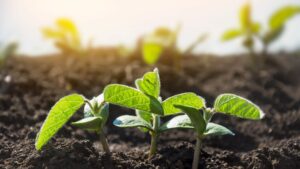Soybean growers may finally have a novel way to tackle SCN
Soybean Cyst Nematode (SCN) is abundant in soybean fields. It steals yields, profits and world-feeding potential every day. In fact, 2024 marks the 50th year that SCN has been the number one disease loss issue in the United States. Researchers across the seed value chain have spent decades studying ways to help soybeans resist SCN, with limited results. In fact, it’s been 60 years since the seed industry saw a new trait to fight the pathogen. That’s hopefully finally changing.
BASF recently announced a new SCN trait they’ve named Nemasphere. The company describes the nematode resistance trait as the first and only biotechnology trait for SCN. The trait employs a novel mode of action while maintaining yield potential. Specifically, the trait utilizes a Cry14 protein that, when ingested by nematodes, disrupts nutrient uptake in their intestines, ultimately causing their death.
While it’s a big win for BASF to lead the industry on a new trait, the trait’s major winners are farmers. SCN is the primary cause of soybean yield loss in the United States, leading to an estimated $1.5 billion in annual yield reductions. Compounding the issue, native SCN traits are losing their effectiveness, so a new solution is a critical priority for the industry.
BASF has conducted advanced field testing of the new trait in North America for eight years, including more than 200 field trials in the United States. On average, the trait enhanced yield potential by 8%. That could grow as SCN resistance to native traits increases.
Julia Daum is a BASF research science manager. She said the path of discovery for the novel SCN-resistant trait was a long and winding road. She began the work nearly 20 years ago.
“I remember thinking that if we could come up with a novel solution for soybean cyst nematode, it would be a game changer for the farmer,” she says. “To get that yield back that SCN is robbing from them would be game changing.”
It took nearly 10 more years for Daum to discover the novel Cry14 protein that would form the basis of Nemasphere™. She took that discovery to BASF trait development manager Michael McCarville in 2016.
“When I met Julia back in 2016, I had already been working on SCN for almost a decade,” he says. “I had worked eight years at this and made absolutely no dents.”
They trialed her solution in Iowa in 2017.
“Not only did we have something that was going to address yield but we have something that’s going to reduce risk for [farmers],” he says.
In addition to providing a new form of SCN resistance, the new trait is a single-locus trait. This enables breeders to integrate it into a wide range of high-yielding seed varieties without compromising agronomic performance and allows access to the Enlist E3® herbicide tolerance trait. The trait is expected to be available in 2028, pending regulatory approval.
BASF U.S. Head of Seeds and Traits Bryan Perry says the innovation is all about farmers.
“When someone asks me, who’s your customer?’ I’ll always answer that my ultimate customer is the farmer,” he says. “If I don’t wake up thinking about something that makes their lives better, their operation be better, then I’ve just put something on a store shelf that nobody ever wants to buy. My father-in-law was a dairy farmer and a Cooperative Extension agent. He told me something I always have to keep in mind is helping our farmers make more money. He said if we’re helping them do that, we’re doing the right thing.”











